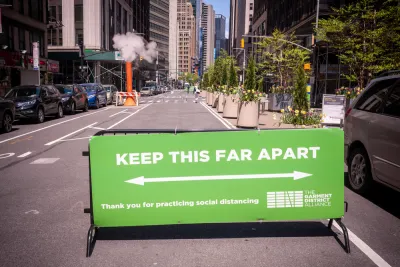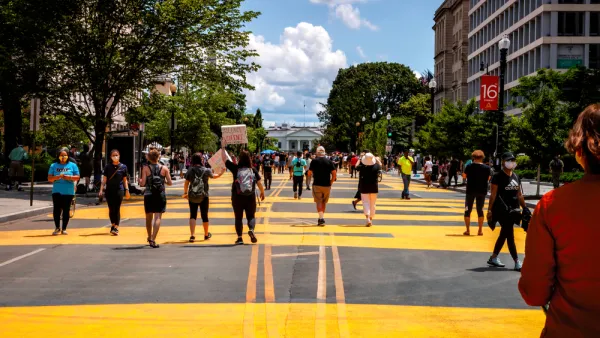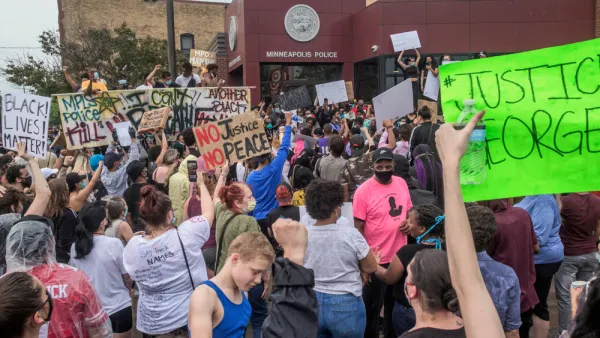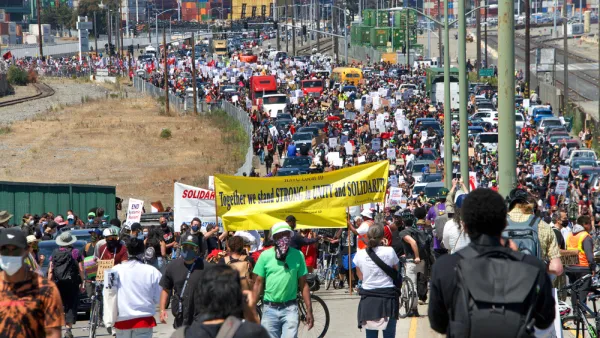The ongoing debate about the role of marginalized communities in the emergency planning programs of the pandemic has now been detailed on the pages of the New York Times.

An article by Emily Badger for The New York Times amplifies an ongoing debate about planning processes during the pandemic—emergency efforts to reshape the public realm to create more space for pedestrians and restaurant and retail businesses—failing the equity test of including marginalized and under-served communities.
The primary source for Badger's coverage of the debate is Destiny Thomas, whose writing on this subject was shared here on Planetizen in June, and who has also been a source in other articles raising the same issues.
Here's how Badger summarizes the debate:
Today, visions of urban life reinvented for the future are colliding with unaddressed inequalities from the past. And the urgency of a public health threat is pushing against demands for the long work of inclusion.
So the questions raised by the debate are questions about the fundamental processes and outcomes of planning: who gets to make the decisions about the future of cities and communities, and how are planners reckoning with the racist and discriminatory outcomes of previous generations of planning decisions?
As an example of the reforms proposed by Thomas, Badger includes the following:
Ms. Thomas, the anthropologist-planner, who leads a team of strategists called the Thrivance Group, says traditional public meetings aren’t her idea of engagement anyway. Instead, she suggests cities could fund community health clinics or food banks already serving these neighborhoods to engage residents on what they need from the city at the same time. City departments could also put community residents on staff to do this work. Ms. Lemar proposes using elementary schools to reach families who would never attend public meetings.
The article treats Oakland's slow streets specifically as a case study for the issues of representation and political power in planning during the pandemic, while raising the larger implications of those experiences for the practice of planning and community engagement for planners around the country by citing academics and advocates from around the country.
FULL STORY: The Pandemic Has Pushed Aside City Planning Rules. But to Whose Benefit?

National Parks Layoffs Will Cause Communities to Lose Billions
Thousands of essential park workers were laid off this week, just before the busy spring break season.

Retro-silient?: America’s First “Eco-burb,” The Woodlands Turns 50
A master-planned community north of Houston offers lessons on green infrastructure and resilient design, but falls short of its founder’s lofty affordability and walkability goals.

Delivering for America Plan Will Downgrade Mail Service in at Least 49.5 Percent of Zip Codes
Republican and Democrat lawmakers criticize the plan for its disproportionate negative impact on rural communities.

Test News Post 1
This is a summary

Test News Headline 46
Test for the image on the front page.

Balancing Bombs and Butterflies: How the National Guard Protects a Rare Species
The National Guard at Fort Indiantown Gap uses GIS technology and land management strategies to balance military training with conservation efforts, ensuring the survival of the rare eastern regal fritillary butterfly.
Urban Design for Planners 1: Software Tools
This six-course series explores essential urban design concepts using open source software and equips planners with the tools they need to participate fully in the urban design process.
Planning for Universal Design
Learn the tools for implementing Universal Design in planning regulations.
EMC Planning Group, Inc.
Planetizen
Planetizen
Mpact (formerly Rail~Volution)
Great Falls Development Authority, Inc.
HUDs Office of Policy Development and Research
NYU Wagner Graduate School of Public Service





























